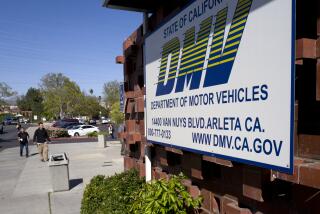In Popular ’55 Alive’ Classes, the Focus Is on Safety, Not Speed, at Any Age
For Norma D’Alessandro, the lights started dimming three years ago.
“I had trouble with my eyes,” said the 65-year-old San Clemente resident. “I began experiencing night blindness.”
D’Alessandro took several measures. She began limiting her driving at night. She avoided dangerous roads. And she took a course called 55 Alive that, among other things, saves her and her husband $280 a year on auto insurance.
Sponsored by the American Assn. of Retired Persons, the course is offered at senior citizens centers, hospitals, churches, retirement homes and other places where older drivers might meet.
In the first nine months of this year, more than 14,000 drivers have taken the classes in Los Angeles County, according to Jackie Ploen, an associate coordinator for the AARP in the western section of the county.
“People are waiting to get into the classes; we’re booking solid,” Ploen said. “Santa Monica Hospital books three to four months ahead of time.”
The classes are aimed at drivers 55 and older who, according to statistics, are responsible for more than their share of traffic accidents and citations. By 2020, one of four drivers in the United States and Western Europe will be over 65, according to Transportation Research Board estimates.
*
“We’ve had [students] as young as 50. The average age is around 70. I had one man in a class who was 100 years old,” Ploen said.
“One of my instructors is 85. He drives all over the county to teach the class and he teaches about every day of the week,” she added.
The course includes everything from advice on driving under the influence of medications to special calisthenics for limbering up stiff necks that prevent some older drivers from looking around when changing lanes or backing up.
Although statistics show that people tend to drive less as they get older, thereby accounting for fewer accidents, the accident rate per miles driven begins to rise around age 55, with a dramatic jump occurring at age 80.
During recent years in California, for instance, drivers 55 and older have averaged 0.71 accidents per 100,000 miles driven, compared to 0.37 accidents for drivers age 20 to 54, according to statistics from the California Highway Patrol and the Department of Motor Vehicles. The only group with a higher accident rate is drivers 16 to 19, who averaged 0.84 accidents per 100,000 miles.
Experts attribute the high accident rate among older drivers to a number of physical and mental changes associated with aging. As people age, vision begins to fade, hearing decreases and the gradual loss of sensory acuity increases the amount of time required to process information and make decisions.
While younger drivers tend to commit traffic violations such as speeding, drunk driving or reckless driving, the experts say, older drivers are more likely to be involved in making dangerous left turns or lane changes, failing to observe the right of way or failing to stop at stop signs.
*
“The AARP courses teach more of the safety aspects of driving. Because drivers over age 55 have declined in physical capabilities, we emphasize making people aware of that,” said Harold Muraoka, the group’s assistant coordinator for the San Fernando Valley.
Among the bits of advice offered in the course: Allow plenty of time and plan ahead by charting your course in advance; avoid especially stressful situations such as driving during peak traffic hours or late at night; and learn to recognize and accept that the day will come when your best course of action will be to hang up your keys.
AARP officials say insurance industry studies indicate that graduates of their course file 10% fewer accident claims. However, a 1995 study by the Department of Motor Vehicles found that such courses do not appreciably decrease the number of fatal accidents in which older drivers are involved.
“Many of [my students] say, ‘Gee, we’ve been driving for 50 years and we’re going to be better drivers now,’ after taking the class,” Ploen said.
Legislation in 34 states, including California, requires insurance companies to offer discounts to drivers who, at least once every three years, take the AARP course or similar programs such as the one offered by the Automobile Club of Southern California. Students in the Los Angeles-area classes have reported discounts on their insurance polices of up to 15%, Ploen said.
“As a senior, that money means a lot to me,” said Doris Fortner, 69, who recently took the course for the second time at the Dana Point Senior Center in Orange County.
The course itself costs $8 for two four-hour segments.
Virginia Crosley, 74, said she decided to take the AARP course in part to learn how to cope with the increasing complexities of modern commuting. “Sometimes I think my reflexes aren’t what they should be,” the San Clemente resident said, “but generally, I consider myself a good driver.”
*
Although she said she has never had an accident and has received only one ticket, driving in California today is a good deal more challenging than it was in 1942 when she first got her license, Crosley said.
“Today there is too much traffic, too many people and a lot less courtesy,” she said. “When you consider how many people are drinking and taking drugs, it’s a lot more dangerous out there.”
For Dorothy Nido, 70, of Monarch Beach, like D’Alessandro, the changes in driving abilities have centered on vision. “I don’t drive at night anymore because of depth perception,” she said.
David Brown, 58, said he took the course to, among other things, begin compensating for a perceived loss of mental and physical agility in driving. “You’re not as quick as you were,” said Brown, of Capistrano Beach. “You’re just not what you were when you were 45.”
Which is precisely the point, according to Dave Dugan, 65, a former CBS news correspondent and retired college professor who teaches the course in Dana Point.
“Every age group has its problems,” he said recently, as class members bent their necks and twisted their torsos in preparation for safer driving. “We want seniors to take care of theirs.”
More to Read
Sign up for Essential California
The most important California stories and recommendations in your inbox every morning.
You may occasionally receive promotional content from the Los Angeles Times.










